ANCIENT ART IN JAPAN
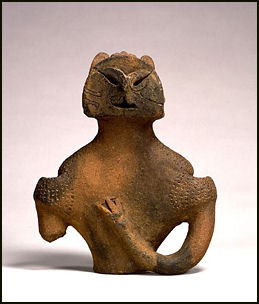
Jomon clay figure
over 4,000 year old The first settlers of Japan, the Jomon people crafted clay figurines called “dogu”, many of which represented women. Afterwards, the Yayoi people (approximately 300 B.C. to A.D. 300), whose core was a different immigrant group in the beginning of the era, manufactured copper weapons, bronze bells, and kiln-fired ceramics. Typical artifacts from the Kofun (Tumulus) period (approximately A.D. 300 to A.D. 710) that followed are bronze mirrors and clay sculptures called “haniwa”, which were erected outside of tombs. The simple stick figures drawn on “dotaku”, bells produced in the Yayoi period, as well as the murals adorning the inside walls of tombs in the Kofun period, represent the origins of Japanese painting. [Source: Web-Japan, Ministry of Foreign Affairs, Japan]
Painting began to flourish in the sixth century, when the ruling class took great interest in Buddhism and Buddhist culture, which had arrived from Korea and China. Paintings preserved from the late seventh and early eighth centuries were executed in styles developed in China in the late period of the Six Dynasties (222--589). They illustrate the life of Buddha and depict other Buddhist deities. [Source: Web-Japan, Ministry of Foreign Affairs, Japan]
“After the tenth century, painting became increasingly influenced by “Jodo Shinko “(Pure Land Buddhism). With impetus from the ruling class, temples and monastic compounds were constructed in various locations from the late sixth to the early seventh century. Notable examples are Asukadera, Shitennoji, and Horyuji. In the interior of these temple complexes, especially the halls and chapels, a substantial amount of Buddhist art was commissioned. The murals in Horyuji’s Kondo (Golden Hall) are some of the most important paintings of the period. We can also see sculptures representing various Buddhas, Bodhisattvas, and guardian deities in these temples. Prime among them is the Shaka Trinity, a sculpture housed at Horyuji.
“By the middle of the Heian period (794--1185), a clearly indigenous style, called “yamato-e”, had begun to replace Chinese modes of painting. “Yamato-e “depicts the scenery around Kyoto, and its earliest examples are seen on sliding and folding screens. Along with this new, native style came two new formats for painting: the album leaf and the illustrated handscroll, called “emaki”. “The Tale of Genji Scrolls “(ca. 1120) are the most famous “emaki”. In the late twelfth century, although power shifted remarkably from the nobility to the “samurai “class, the nobility, as well as the administrators of temples and shrines, continued to retain great wealth and remained as patrons of various genres of art.
Websites and Resources
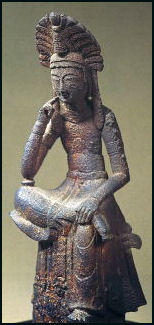
bosats Good Websites: Japanese Art and Archeology art-and-archaeology.com ; World Art Treasures Japanese Sculpture bergerfoundation.ch ; Buddhist Art of Japan buddhist-artofjapan.com ; Japanese Buddhist Statuary onmarkproductions.com ; Identifying Buddhist Images in Japanese Painting and Sculpture aasianst.org/EAA ; British Museum on Japanese Buddhist Statuary britishmuseum.org ; Miho Museum near Kyoto miho.or.jp ; Miho Museum Photos danheller.com
Good Websites and Sources on Japanese Art: Artelino on Japanese Art artelino.com ; Web Japan web-japan.org/museum/paint.html ; Japanese Art Portal japaneseart.org ; ; Japanese Art and Architecture from the Web Museum Paris ibiblio.org/wm ; Zeroland zeroland.co.nz ; Asia Society Virtual Tour asiasociety.org ; Daruma, Japanese Art and Antiques Magazine darumamagazine.com ; Art of JPN Blog artofjpn.com
Art History Sites Art History Resources on the Web — Japan witcombe.sbc.edu ; Early Japanese Visual Arts wsu.edu:8080 ; Japanese Art History Resources art-and-archaeology.com ; Books: “History of Japanese Art” by Penelope Mason (Harry N. Abrams, 1993); “The People' Culture — from Kyoto to Edo” by Yoshida Mitsukuni (Cosmo Public Relations Corporation, Tokyo, 1986); “The Shaping of Daimyou Culture, 1185-1868" by Martin Collcut and Yoshiaki Shimizu (National Gallery of Art, 1988).
Art Museums in Japan Columbia University Page on Collections of Japanese Art columbia.edu ; Tokyo National Museum site tnm.go.jp ; Kyoto National Museum official site kyohaku.go.jp ; Tokugawa Art Museum tokugawa-art-museum. ; National Museum of Japanese History rekihaku.ac.jp ; Nara National Museum narahaku.go.jp ; Kyoto University Museum inet.museum.kyoto-u.ac.jp ; National Museum of Art, Osaka nmao.go.jp ; National Research of Cultural Properties Tokyo tobunken.go.jp ; National Research of Cultural Properties Nara nabunken.go.jp/english ;Miho Museum near Kyoto miho.or.jp ; Photos danheller.com
Museums with Good Collections of Japanese Art Outside of Japan ; Columbia University Page on Collections of Japanese Art columbia.edu ; Metropolitan Museum of Art metmuseum.org ; Sackler Museum in Washington asia.si.edu/collections ; Museum of Fine Arts, Boston mfa.org/collections ; British Museum britishmuseum.org ; Los Angeles County Museum of Art lacma.org/art ; Ruth and Sherman Lee Institute for Japanese Art Collection ucmercedlibrary.info
Links in this Website: JAPANESE CULTURE Factsanddetails.com/Japan ; JAPANESE CULTURE AND HISTORY Factsanddetails.com/Japan ; CLASSICAL JAPANESE ART AND SCULPTURE Factsanddetails.com/Japan ; JAPANESE PAINTING Factsanddetails.com/Japan ; EDO PERIOD ART Factsanddetails.com/Japan ; UKIYO-E, HOKUSAI, HIROSHIGE Factsanddetails.com/Japan ; JAPANESE CRAFTS Factsanddetails.com/Japan ; JAPANESE POTTERY AND LACQUERWARE Factsanddetails.com/Japan ; JAPANESE ARCHITECTURE Factsanddetails.com/Japan ;
Early Pottery and Art in Japan
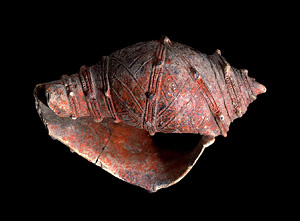
shell art over 4,000 years old People living in Japan were the first known people to use pottery. Pottery from Japan dated to 10,000 B.C. is the oldest known in the world. Pottery is made by cooking soft clay at high temperatures until it hardens into an entirely new substance — ceramics. The pottery of the Jomon people was decorated with markings made by pressing lengths of cord into the wet clay before firing.
The Jomon people, who lived from 10,000 and 400 B.C., made fantastic designs on the edges of their pottery, wore large earrings and other jewelry, made a variety of ritual objects including phallic rods and ritual knives. Most impressive were their ritual clay figurines that possibly represented gods or were symbols of fertility.
The Yayoi Period (400 B.C.-A.D. 300) is named after the Yayoi-type of wheel-turned pottery vessels produced during this period. The Yayoi people are believed to have come from the Korean peninsula about 300 B.C. Yayoi pottery resembles pottery produced in Korea at the same time. The technique of weaving clothes arrived from China around 300 B.C. Early fabrics were made from hemp (for commoners) and silk (for nobility). Some were dyed red with an herb called madder.
Dogu
Dogu are thought to have been prayer figures used in prayers for prosperity and fertility. There are different types. Some female dogu have big butts and hips. Others have babies in their arms. Many are nude and pregnant. Some male dogu have heavy beards and big chests. Dogu faces are remarkably varied. Many have different expressions depending on the angle from which they are viewed.
Dogu were shaped and decorated using sticks and rope. Their designs and the situations in which they were found vary a great deal leading some to speculate that there were animism symbols, funeral objects or healing dolls. Similar ceramic figures were created in Europe and western Asia in the new Stone Age (8,300 to 5,000 B.C.) as Earth Mother figures associated with agriculture. Dogu are not associated with agriculture because they appeared in Japan before agriculture did.
Tokyo National Museum curator Yoichi Inoue told the Daily Yomiuri, “The dogu’s designs emphasized body parts that weren’t part of the male form, such as the organs needed in giving birth, showing us that those people weren’t interested in the mysteries of life. They are prayers for a safe delivery. Fertility leads to prosperity in tribes and eventually brings productiveness and prosperity in society.”
More than 18,000 dog figures have been unearthed throughout Japan. More than 2,000 dogu have been unearthed in Iwate Prefecture; so many that a guidebook on them has been published. The British Museum possesses a number of dogu and has hosted a dogu exhibition.
Early Buddhist Art in Japan
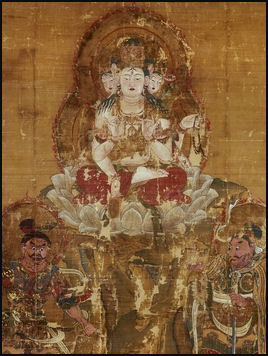
12th century Buddhist painting The first inhabitants of Japan made pottery vessels and sculpture, but art that rose above the level of folk art wasn't really generated until Buddhism and Buddhist styles of painting, sculpture and architecture were introduced from Korea and China in the A.D. 6th century.
The earliest forms of Buddhist art were paintings with a strong Indian influence and ornate mythical beast under the eaves of early Buddhist temples. Buddhism reached its zenith shortly after Nara, Japan's first capital, was established in A.D. 710. The city contained many magnificent temples and religious structures, including the colossal Todaiji Temples and the Daibatsu (Great Buddha Statue).
Daibutsusan in Nara is the world's largest bronze Buddha. Originally constructed between 735 and 749, the colossal sitting Buddha statue is 72 feet high, weighs over 550 tons and is covered with almost 300 pounds of gold.
The Buddha is a representation of the Cosmic Buddha, who gives rise to new worlds. Buddhists now believe the statue emits divine light to the far corners of the universe and each lotus leaf it sits upon represents a separate universe. The Buddha is believed to have built to ward off small pox and show off the power of Emperor Shomu, who is said to have wanted a Buddha large enough to bring good fortune to everyone. The Great Buddha was completed three years after his death.
Buddhism arrived in Japan after it had been on the Asian continent fore nearly a thousand years and had developed a rich diversity of iconography. The development of Buddhist art in Japan as it was in other places was an exercise of selective emphasis and adaption. The taste of the aristocratic class, which patronized the arts, favored works that were awe-inspiring, supported existing worldly power structures and emphasized visual representations of abstract concepts rather than depicting narratives. The images focused on divine hierarchies, perceptions of ultimate reality and meditative paths to enlightenment.
China and the Development of Uniquely Japanese Art

Tang-style sculpture Japanese art and culture was influenced deeply by the Chinese Tang Dynasty (A.D. 618-906). Japanese Hakuho sculpture and Manyoshu poetry were both modeled on Tang styles. Tang art was ultimately rejected because it was considered too ornamental and excessively decorative for Japanese tastes. China was also the source of Zen Buddhism, which had a great influence on Japanese art.
See China, Art, Chinese Painting
Contacts with China were interrupted at the end of the 9th century and Japanese culture and art began to take on characteristics that was uniquely its own and develop art that in many ways was a simplified and refined version of Chinese art.
During the Heian Period (794-1185), the administrative duties of the Imperial Japanese court was left to minor officials, leaving members with free time to pursue their interest in art, culture, beauty, nature and sex. Wonderful art was produced during this time.
Shingon Esoteric Buddhist Art
Shingon esoteric Buddhism places great importance on visual forms such as mandalas, paintings, sculptures and ritual articles. The statues from Kodo Hall at Toji temple are particularly well-known works. Eight statues from the hall, including two mystical myoo wisdom kings, a dignified Taishakuten and a fierce Jikokuten are greatly treasured. [Source: July 22, 2011]
Other important pieces in the exhibition include plush monk headpieces known as Shakujoto, a highly elaborate niche adorned with various buddhist figures known as Shoson-Butsugan, and portable shrines adorned with Buddhist figures, all brought to Japan from China by Kukai. Ryokai (two worlds) Mandala, also known as Takao Mandala, is the oldest existing work of its kind. Works by Kukai himself include five autographed calligraphy pieces.
Kukai greatly influenced his senior disciples, who went on to produce some powerful Buddhist art themselves. The Yakushi Triad from Daigoji temple and the Amida Nyorai with Attendants from Ninnaji temple, both dating back to the early Heian period, contain fine examples of this.
Zen Buddhism and Japanese Art
Introduced to Japan from China during the Chinese Sung Dynasty (A.D. 960-1279), Zen Buddhism had a profound influence on Japanese art. Different from other Buddhist sects that preceded it and oriented more towards appreciation than worship, Zen eschewed art that was formalistic and ornamental and favored art that was disciplined, restrained, simple, and expressed inner feeling and harmony with nature.
Zen disapproval of Buddha images gave birth to a new tradition of human portraits and statues and marked the "beginning of a secularization of art which would gain in momentum in the following centuries."
In the Kamakura period (1185 and 1333) and Muromachi period (1333-1576) Zen had a large impact on Japanese art and culture as manifested in the tea ceremony, flower arrangement, calligraphy, ink paintings, haiku poetry, gardening, sculpture and textiles.
Tea Ceremony and other Zen Art Forms, see Art, Tea Ceremony
Buddhist Sculpture in Japan
Most of the really old art works found in Japan are Buddhist sculptures made for Buddhist temples. More sculptures remain than paintings because more sculptures wee probably made and paintings tend to deteriorate with time. Buddhist sculptures are generally made from wood or bronze. Some are gilded.
The introduction of Mahayana Buddhism in the 6th century marked the beginning of the development of Japanese fine arts. At this time artisans turned their attention from ceramics and metalwork to Buddhist images, namely sculptures. Many pieces were made by Korean and Chinese immigrants. Those wee made by Japanese were almost copies of works from Korea and China.
Sculpture was also very much alive as a folk art. During the Heian period (794-1192) 70-centimeter-tall wooden deity statues were placed along road to ward off evil spirits that cause problems for travelers.
The Kamakura period (1185-1333, whose name is taken from the place where the new seat of government was established, is characterized by two major trends: realism, which aimed to satisfy the taste of the “samurai “class, and conservatism, which epitomized the nobility’s taste in art. Realism is most manifest in the form of sculpture. Unkei, the most noted sculptor of the Kei school (creators of a realistic sculptural style), has among his most accomplished works the two Nio guardian images at the gate of Todaiji and the wooden sculptures of two Indian sages, Muchaku and Seshin, at Kofukuji. [Source: Web-Japan, Ministry of Foreign Affairs, Japan]
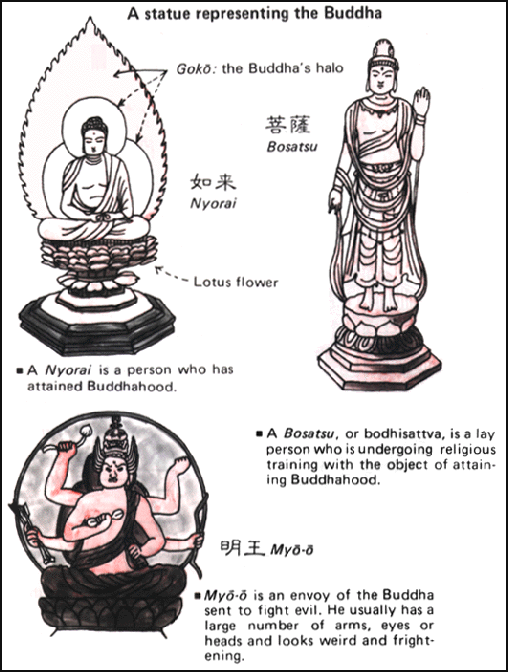
Types of Buddhist Images in Japan
There are four main types of Buddhist sculptures found in Buddhist temples, each conveying a different level of being in Buddhist cosmology: 1) “Nyorai” (“images of Buddha”); 2) “bosatsu” (“bodhisattvas”); 3) deities and spirits such as “ten” (“heavenly being or devas”) and “nio” (“guardians”); and 4) “myoo” (“kings of wisdom and light that serve as protectors of Buddhism”). The most common myoo, Fudo Myoo, is usually a menacing-looking holding an upright sword.
Bosatsu are distinguishable from nyorai by a more human like appearance and a top knot of hair or a crowed headpiece, sometimes with smaller figures in the crown. One of the most common bodhisattvas found in Japanese temples is Jizo, a bodhisattva who helps children and travelers. Kannon (Avalokitesvara) appears in 33 different manifestations, including the Goddess of Mercy, is also very popular, especially with pregnant mothers.
There are hundred of gods in the Buddhist pantheon. Many have been borrowed from Hinduism to serve a particular purpose in Buddhist cosmology. Some have a humanlike appearance. Others look like monsters. These are often used as guardians to guard the gates entering a temple. Images found in temples vary according to sect and the period in which the temple was constructed.
Images of Buddha in Japan
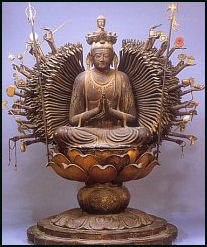
8th century furji dera
Nyorai images are recognizable by their simple robes, lump on the head (symbolizing wisdom) and "snail shell" curls of hair. Common images found in temples include 1) Shaka (the Historical Buddha), recognizable by one hand raised in a praying gesture; 2) Yakushi (the Healing Buddha), with one hand raised in the praying gesture and the other holding a vial of medicine;
3) Amita (Buddha of the Western Paradise), sitting down with the knuckles together in a meditative position; 4) Dainichi (the Cosmic Buddha), usually portrayed with in princely clothes, with one hand clasped around a raised a finger on the other hand (a sexual gesture indicating the unity of being; and Maitreya (Buddha of the Future).
Nyorai images are often depicted with two bodhisattvas in a triad configuration and/or are backed by a nimbus a (large wooden board with Buddha and other images carved or painted on them).
Wooden Sculpture in Japan
Many of the most outstanding works of Buddhist sculpture are made of wood.
Among the different of types of wooden sculpture are 1) “ichiboku” statuary sculptured made from a single block of wood; 2) “natabori”, hatchet sculptures deliberately left notched with chisel scars and often made from wood from sacred trees in an attempt to capture The Buddha at the moment he emerges from the wood; 3) “byakudan”, sculptures made of sandalwood or another fragrant wood.
Sandalwood sculptures ted normally be about 40 centimeters tall, because the wood is fine-grained the clothes and accessories are craved with exquisite detail. They are coated din light natural colors of left unfinished.
Many ichiboku and natabori works are life size or large than life size. Many ar emade of cypres wood. Ichiboku were replaced by joint-block figures in mid Heian period.
Golden Ages of Japanese Sculpture
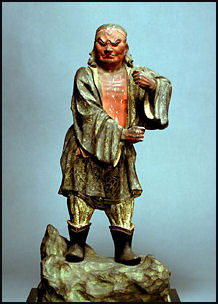
The Nara period (A.D. 710-794) was a golden age for Japanese sculpture. Sculptures from this period were mostly serene Buddha figures made of clay. In this period Buddhist sculptors matured from making two dimensional figures into making startling, almost eerie, realist works of art that the rapidly developed a Japanese flavor with an “almost subliminal inclusion of nature motifs and natural or casual poses." Masterpiece from this period include the Yakushi Triad, which can be viewed at Yakushi Temple in southern Nara and the Ganjin statue at Nara's Toshodaiji Temple.
Some of the better pieces from the early Heian Period (794-1185) are curvaceous and have full-figured bodies carved from a single piece of wood. Some famous early pieces are said o have been made by Kukai (774-835), a Buddhist priest popularly known as Kobo Daishi. Pieces from the late Heian period are mostly gilded bronze Buddhas.
Many of most famous ichiboku were produced in Nara. On a famous piece called “Standing Eleven-head Kannon” produced in the Lake Biwa area, the essayist MasaShiraru wrote: “When I unexpectedly encounter the beautiful Kannon...I really felt I was seeing Buddha...The posture was gentle and supple like a breeze that blows over the lake water.”
After the samurai classes took control of Japan in the late 12th century, two major Buddhist movements gained prominence: one was an indigenous populist Buddhists and the other was Zen. Both forms had been around for some time but gained prominence in this period. Both emphasized simplicity and getting back to basics.
The golden age of Japanese sculpture was in Kamakura Period (1192-1333), when wooden statues of a wide range of subjects, including serene hermits, fierce warriors and omnipotent gods, were carved with wonderful detail and realism from blocks of woods fit together. Some the wooden figures feature realistic even humorous poses.
Japanese mandalas, unlike heir Himalayan counterparts, are sometimes f real places, One mandala o the famous Nachi Shrine with its famous waterfall is surrounded by low-lying cloud and densely-needed pine trees. The paths among the buildings are a road to enlightenment,
Kokei, Unkei, Famous Japanese Sculptors
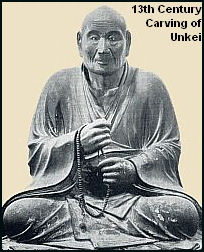
Famous sculptors include Kokei (active in the late 12th and early 13th century) and his son Unkei (died 1223). Unkei produced magnificent wooden sculptures with crystals inset in the eyes. His images of important figures in Japanese Buddhism are known for being expressive and austere.
Kokei worked during the Heian period (794-1192) and early Kamakura period (1192-1333). He made sculptures of Buddha from cypress wood. Experts determine works made by him based on pleats in clothing and the shape of the ears.
Unkei lived in the early Kamakura period. The years of his birth is unknown. He developed the Kamakura-style of carving and led the Nara-based Kei school of Buddhist sculpture. He played a major role in rebuilding large temples ruined by battles that took place in the Heian period.
Only 13 works have been positively identified as Unkei works. Of these five have been designated national treasures and seven as important cultural assets.
Enku and Mokujiki were two famous Edo period sculptures, Enku is known for his sharp, improvised carving style. Mokujiki produced round and humorous faces.
Big Money for a Japanese Sculpture

$14.4 million sculpture In March 2008, a seated wooden statue of the sun goddess Dainich Nyorai was sold at a Christie’s auction for $14.4 million, making it the most expensive Japanese or Buddhist artwork ever sold. The work, believed to have been made bu Unkei, was purchased by department store operator Mitsukoshi on behalf of an unidentified customer.
The Dainich Nyorai statue is made of Japanese cypress and is 66.1 centimeters tall. It was expected to fetch a price of between $1.5 million and $2 million. Usually works of this kind are designated important cultural assets by the Japanese government and not sold without government permission . The government declined to give the work a cultural asset rating even though X-rays done at the Tokyo National Museum found a crystal bead and wooden plate inside the sculpture like those used by the school led by Unkei. The style and features on the work indicate that it was likely made by Unkei.
The buyer of the Dainich Nyorai turned out to be a Buddhist Temple in suburban Tokyo. The Shinnyo -en temple said it bought the statue with donations to prevent it from falling into foreign hands. The purchase of the statue by Japanese meant he the work would likely stay in Japan. The work is likely to be declared a national treasure.
The previous record for the sale of a Japanese work was $1.76 million paid for a 17th century folding panel painting titled “Rakuchu Rakugai-zu” (“Scenes In and Around Kyoto”) that was old in New York in March 1990.
Image Sources: Onmark Productions, Tokyo National Museum, British Museum, Ray Kinnane
Text Sources: New York Times, Washington Post, Los Angeles Times, Daily Yomiuri, Times of London, Japan National Tourist Organization (JNTO), National Geographic, The New Yorker, Time, Newsweek, Reuters, AP, Lonely Planet Guides, Compton’s Encyclopedia and various books and other publications.
Last updated October 2012
